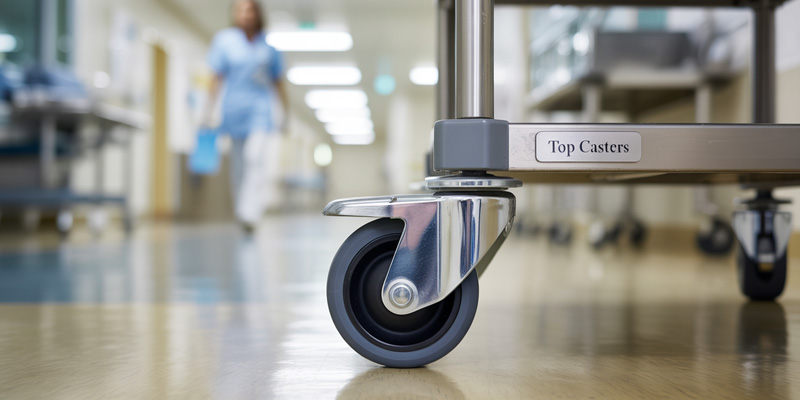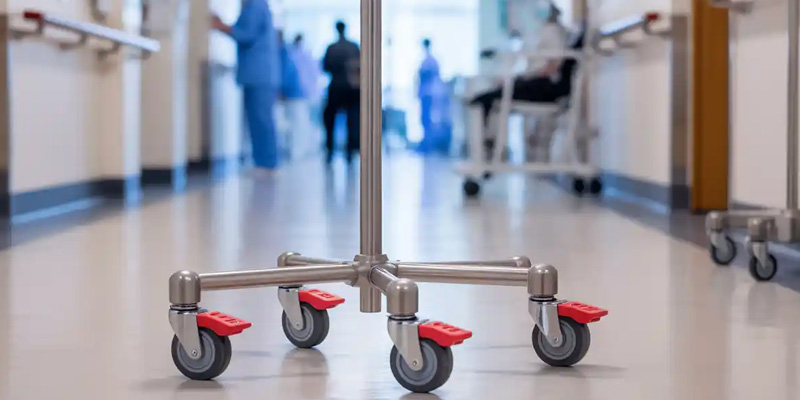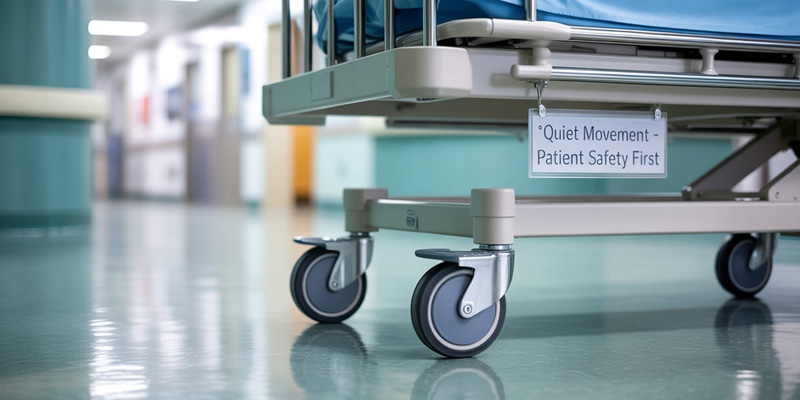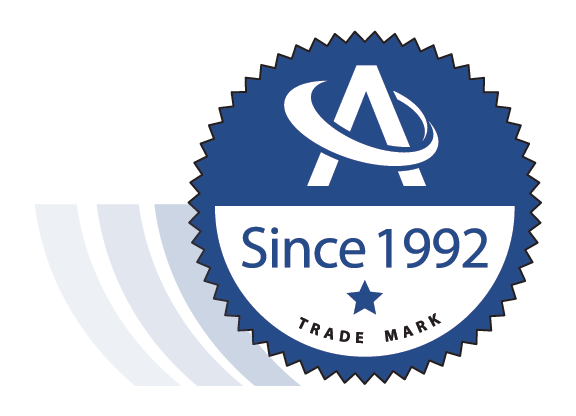Top Casters for Mobile Medical Equipment in Hospitals and Clinics
Sep 17th 2025
Introduction: Why Choosing the Right Casters is Crucial in Healthcare
In a hospital or clinic, mobility is a critical factor that influences how smoothly medical operations run. Whether it's rolling a medical cart down a busy hallway, transporting a patient on a gurney, or moving heavy diagnostic machines, the need for smooth, efficient, and safe movement is ever present. That’s where casters for medical equipment come in. These small yet powerful components are essential to healthcare settings as they allow for the seamless mobility of critical equipment.
The correct medical grade casters provide unparalleled benefits, enhancing patient care, staff productivity, and operational efficiency. Without the right casters, mobile medical equipment can be difficult to maneuver, increase the risk of accidents, and lead to delays. Choosing the proper casters can enhance the safety of the environment, ensuring that every piece of medical equipment operates at its highest potential.
In this blog post, we will explore the top 5 casters used in hospitals and clinics, discussing why each one plays a vital role in healthcare facilities. We’ll also provide a comprehensive guide on selecting the right casters for your specific medical needs.
The Importance of Medical Grade Casters for Healthcare Equipment

In the world of healthcare, precision, safety, and hygiene are paramount. Medical equipment is a significant investment, and keeping it functional for years to come is crucial. Medical grade casters are specifically designed to meet the rigorous demands of the healthcare industry. These casters for medical equipment are built to be durable, easy to maintain, and capable of withstanding the frequent movement required in hospitals, clinics, and care facilities.
Why Medical Grade Casters?
Medical grade casters are crafted from superior materials that meet safety and hygiene standards. These casters are designed to move smoothly across various hospital floors, ensuring that mobile equipment, such as gurneys, stretchers, and diagnostic carts, can be maneuvered effortlessly. They also come with specific features like locking mechanisms to ensure stability, rigid casters for straight line movement, and heavy duty swivel casters for flexible movement.
Key Features of Medical Grade Casters:
- Hygienic Properties: Medical grade casters often feature sealed bearings that prevent dirt and debris from entering, ensuring easy cleaning and maintaining infection control.
- Locking Mechanisms: Locking swivel casters are essential in preventing unwanted movement, especially in areas where medical procedures are performed, or when equipment needs to remain stationary for extended periods.
- Durability: These casters are designed to last under the constant stress of moving equipment throughout the hospital or clinic, handling weights without compromising performance.
Medical grade casters should be used for any equipment that requires reliable mobility and needs to meet high standards of cleanliness and durability.
Heavy Duty Casters for Enhanced Load Bearing and Stability
Healthcare equipment often comes with heavy duty components that require casters that can support substantial weight. From large medical carts and diagnostic equipment to hospital beds and stretchers, heavy duty casters are indispensable in ensuring these items move with ease while staying secure. These casters are specifically designed to handle much more weight compared to standard models, providing stability and durability where it’s needed most.
Why Heavy Duty Casters?
The primary reason to choose heavy duty casters for medical equipment is their ability to carry large loads without compromising performance. Equipment such as hospital beds, operating tables, or MRI machines require casters that can withstand weight while still being able to move freely across the healthcare facility’s floors. Heavy duty swivel casters are especially valuable because they allow for increased flexibility and maneuverability, making it easier to navigate tight spaces and hallways filled with people.
Top Benefits of Heavy Duty Casters:
- Load Capacity: Heavy duty casters can support loads of up to 1000 lbs, which is ideal for heavy equipment such as mobile diagnostic machines or large hospital beds.
- Maneuverability: While rigid casters offer straight line movement, heavy duty swivel casters allow for superior movement in all directions, offering flexibility in moving cumbersome equipment in tight hospital rooms.
- Durability: These casters are built for the long haul. They are designed to endure the constant movement required in a hospital setting without showing signs of wear and tear.
By choosing heavy duty casters, healthcare facilities can ensure that even the heaviest pieces of medical equipment can be moved safely and efficiently, minimizing strain on staff and equipment.
Swivel Casters for Smooth Movement

For equipment that needs to be maneuvered through tight spaces, such as crowded patient rooms or narrow hallways, 3 inch swivel casters and 4 inch swivel casters offer the best solution. Swivel casters are designed to rotate 360 degrees, giving medical staff the ability to push or pull equipment in any direction with minimal effort.
Why Choose 3 Inch and 4 Inch Swivel Casters?
- 3 inch swivel casters are ideal for small medical carts or mobile IV stands, allowing for effortless movement around tight corners and narrow spaces.
- 4 inch swivel casters provide more stability and support, making them perfect for larger medical carts or equipment that requires smooth, controlled movement.
Key Advantages:
- Smooth Movement: Swivel casters provide agility, allowing medical staff to change direction with ease, which is essential in busy healthcare settings where quick movements are necessary.
- Noise Reduction: Hospitals and clinics are places of healing, and noise reduction is important. 3 inch swivel casters and 4 inch swivel casters are often designed to operate quietly, ensuring they don’t disturb patients during treatment.
- Durability: Swivel casters are built for frequent use, providing long lasting performance in high traffic environments.
These swivel casters are perfect for ensuring quick and easy movement of medical equipment without compromising safety or stability.
Locking Casters for Safety and Security
Safety is one of the highest priorities in healthcare environments, and locking casters provide an essential function by keeping mobile medical equipment stationary when needed. Medical equipment like hospital beds, surgical carts, and patient transport devices must often remain securely in place during procedures or patient recovery.
Why Locking Casters?
Locking mechanisms are designed to prevent casters from moving once the equipment is in place. Whether it's a heavy duty locking caster or a locking swivel caster, the primary benefit is safety. In operating rooms or patient recovery areas, where stability is crucial, locking casters ensure that equipment doesn’t accidentally move, causing potential harm to patients or staff.
Advantages of Locking Casters:
- Security: Locking casters keep equipment secure, especially in critical areas where stationary equipment is necessary.
- One Step Locking Mechanism: Heavy duty locking casters are designed to be locked and unlocked quickly, even when wearing gloves, making them ideal for fast paced medical settings.
- Versatility: Locking mechanisms are available in both swivel casters and rigid casters, offering a variety of solutions to meet different needs.
Locking casters are an essential part of any mobile medical device that requires precision and security during use. They ensure that equipment stays securely in place when necessary.
Rigid Casters for Stable Movement and Precision
While swivel casters are designed for flexibility, rigid casters provide the stability needed for medical equipment that requires straight line movement. 2 inch rigid casters and 4 inch rigid casters are designed to keep equipment moving in one direction, which is ideal for heavy medical equipment that doesn’t need to be turned frequently.
Why Rigid Casters?
For larger pieces of equipment, such as medical carts, rigid casters provide stability and precision. Unlike swivel casters, which allow for rotation in all directions, rigid casters only move forward and backward, making them ideal for equipment that needs to be maneuvered along a straight path, such as long transport carts or stretchers.
Advantages of Rigid Casters:
- Stability: 2 inch rigid casters or 4 inch rigid casters provide stability, preventing wobbling or tilting of medical equipment.
- Precise Movement: These casters help maintain a straight path, making them perfect for use in hallways or rooms where precise movements are required.
- Heavy Duty: Heavy duty casters can be paired with rigid casters for equipment that requires more robust weight bearing capabilities.
Rigid casters offer a high level of precision and control, making them an excellent choice for mobile medical devices that don’t require turning or rotation.
Key Considerations When Choosing Casters for Different Medical Equipment

Choosing the right casters for medical equipment requires more than just selecting a size and material. Different types of medical equipment have unique needs, and selecting the right caster type will enhance not only mobility but also safety and longevity. In this section, we’ll explore key considerations when choosing casters for various types of medical equipment, from patient beds to diagnostic carts, to ensure that your equipment operates at its optimal level in every environment.
1. Patient Beds and Stretchers: Prioritizing Safety and Comfort
Patient beds and stretchers are among the most commonly moved pieces of medical equipment in any healthcare setting. These pieces of equipment must be mobile enough to be moved easily between patient rooms, operating rooms, and other areas of the facility. However, they also need to be stationary when in use to ensure the safety and comfort of the patient.
What to Look For:
- Locking Casters: Patient beds and stretchers require locking swivel casters to prevent movement during procedures or while patients are being transferred. Heavy duty locking casters with a reliable and easy to operate lock mechanism are a must have.
- Swivel Casters for Easy Maneuverability: When moving patient beds through tight hallways or crowded rooms, swivel casters with 360 degree rotation make it easier to navigate corners and narrow spaces.
- Load Bearing Capacity: Depending on the type of bed, medical equipment, and any additional weight being transported (e.g., oxygen tanks or IV stands), heavy duty casters are necessary to support the combined weight.
Recommended Casters:
- 4 inch swivel casters with a locking feature are ideal for easy movement and secure positioning.
- For bariatric or larger beds, heavy duty casters capable of carrying more than 1000 lbs of weight may be necessary.
2. Medical Carts and IV Poles: Ensuring Agility and Stability
Medical carts are used to store and transport medications, instruments, and other necessary supplies. IV poles, similarly, are frequently moved between patient rooms, requiring smooth and stable movement. For these types of equipment, mobility and stability are key factors to ensure quick access to medical tools and to reduce the physical strain on healthcare workers.
What to Look For:
- Swivel Casters for Easy Navigation: Since medical carts and IV poles are often moved in busy corridors, swivel casters (either 3 inch swivel casters or 4 inch swivel casters) are the best option for making sharp turns and easy directional changes.
- Lightweight but Durable: Carts and poles don't carry heavy loads, but they do need durable casters that can withstand daily use. Steel casters or medical grade casters are ideal in this case as they offer a good balance of strength and weight capacity.
- Locking Mechanisms: For added security, carts should feature locking swivel casters to prevent unintentional movement when the cart is in use or when stationary.
Recommended Casters:
- 3 inch swivel casters for quick, flexible movement in smaller, confined spaces.
- Locking swivel casters for stabilization and safety when in use.
3. Diagnostic Equipment and Mobile Imaging Devices: Stability Meets Precision
Mobile imaging devices, such as portable X ray machines and ultrasound equipment, often need to be moved throughout hospitals and clinics. These pieces of equipment are usually heavier and require casters capable of supporting the weight without sacrificing stability or ease of movement.
What to Look For:
- Heavy Duty Swivel Casters: Heavy duty swivel casters allow for smooth and controlled movement of heavy duty casters wheels while providing the maneuverability required for navigating hospital corridors. These casters should be able to bear the weight of the equipment without compromising performance.
- Rigid Casters for Stability: Rigid casters are also important for diagnostic equipment that needs to be moved in a straight line. For example, imaging devices might be rolled into specific rooms for use and need a stable, straight path. Combining rigid casters with swivel casters will give you the flexibility and stability required for moving heavy medical equipment efficiently.
- Locking Casters for Safety: Since these devices are often used in patient areas or critical zones, locking casters are essential for securing the equipment during use.
Recommended Casters:
- 4 inch swivel casters for precision and maneuverability.
- Rigid casters for controlled, straight line movement in designated imaging areas.
4. Surgical Equipment: Moving with Precision and Safety
Surgical equipment often includes specialized carts that carry essential tools, instruments, and other medical supplies to operating rooms. These carts need to be mobile yet stable, ensuring that delicate equipment remains secure during transport.
What to Look For:
- Heavy Duty Casters: Surgical carts can carry a variety of instruments, so heavy duty casters are required to handle the weight without compromising the ability to move the equipment. For additional security, locking swivel casters should be used to keep the cart stationary during preparation.
- 3 inch or 4 inch Swivel Casters for Tight Spaces: Operating rooms can often be cramped, and swivel casters allow for easy turns and positioning in small spaces.
- Smooth Rolling and Quiet Operation: Steel casters or medical grade casters are necessary to reduce friction, ensuring smooth, silent movement that’s crucial in sterile environments.
Recommended Casters:
- 4 inch swivel casters with locking mechanisms for maneuvering in tight spaces and securing equipment.
- Heavy duty casters for larger surgical carts carrying heavy instruments.
5. Mobile Workstations: Maximizing Workflow Efficiency
Mobile workstations are becoming increasingly common in healthcare environments, as they allow staff to access patient records, administer medications, and perform other tasks while remaining mobile. These workstations often contain computers, medical tools, and charts, which require secure yet flexible mobility.
What to Look For:
- Casters for Mobility and Flexibility: Swivel casters are essential for easy navigation, but heavy duty swivel casters provide added strength and stability to handle the weight of workstations that contain medical technology and equipment.
- Locking Casters: For ensuring that workstations don’t roll away unintentionally while staff members are using them, locking casters should be included.
- 3 inch or 4 inch Casters: Depending on the size and weight of the workstation, 3 inch swivel casters may be sufficient, but larger, heavy duty casters may be required for more robust mobile workstations.
Recommended Casters:
- Heavy duty casters for increased load bearing capabilities and easy mobility.
- Locking casters for stability during work use.
Final Thoughts: Choosing the Right Casters for Your Medical Equipment

Selecting the right casters for medical equipment is a crucial decision in maintaining an efficient, safe, and hygienic healthcare environment. From medical grade casters for reliability and durability to heavy duty swivel casters for smooth maneuverability, choosing the right casters ensures that your medical equipment is not only functional but also safe for both staff and patients.
By considering factors such as load capacity, maneuverability, and safety features like locking casters, you can ensure that your equipment is properly equipped for the demands of a busy healthcare facility. Whether you need swivel casters for easy turning or rigid casters for stability, the right choice of casters will enhance the effectiveness of your mobile medical equipment.
For a reliable solution and expert advice on selecting the best casters heavy duty for your medical equipment, get in touch with Atlanta Caster & Equipment. Let us help you find the perfect solution to keep your medical equipment moving smoothly and safely.




 Email US
Email US
 Hours
Hours
 Visit Our Showroom
Visit Our Showroom




